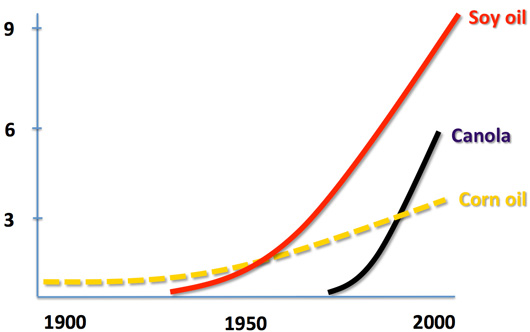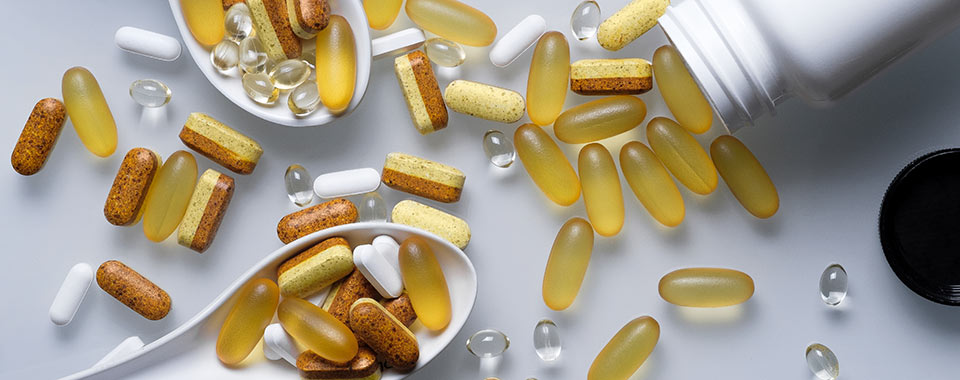Eating fish is strongly correlated to improved mood. *
Our current understanding of the science suggests
- EPA Omega-3 found in fish oil appears to help with mood*
- DHA Omega-3 does not*
- Roughly 1000 – 2000 mg of EPA was found to be a beneficial dose*
But what about your diet?
Can diet have an impact on your mood? Absolutely!
In the last few decades, we have dramatically changed our diet. See graph below.
Seed Oil Consumption (lbs/year) – Last 100 Years
Source: National Institute of Health
We now guzzle down refined seed oils like corn oil and soybean oil. These oils are convenient modern inventions. They are low-cost industrial by-products that did not exist a century ago.
These oils are chock full of an Omega-6 fat called Linoleic Acid.
So what, you say.
Omega-6 and Omega-3 compete for enzymes and placement into cell walls. Our bodies can only store limited amounts of these fats. So an excess of one tends to knock the other one out.
Unpleasant things happen when we shift from eating roughly equal parts Omega-3 and Omega-6, to the modern American diet which has 20 times more Omega-6 than Omega-3.
In an nutshell, this shift in diet produces more hormone-like molecules (called eicosanoids) that increase damaging components and imbalance.
Runaway ‘silent’ imbalance caused by too much Omega-6 (Linoleic acid) has been linked to several health conditions.
Omega-6 linoleic acid actually inhibits EPA Omega-3 from being incorporated into your body.
At the risk of getting too scientific, it’s not the Omega-6-rich seed oil itself that causes the problem. It’s what your body does with the linoleic acid (LA) that matters. LA can get converted to Arachidonic Acid (AA) and THAT’S the problem. AA and its byproduts are potentially harmful. More on this later.
Read these bullet points and look again at the red line in the graph above:
- Soybean oil is about 60% Omega-6
- Soybean oil contributes almost 10% of our calories
- Our soybean oil consumption has gone up 56,000% in the last century
- Omega-6 is associated with poor inflammation response*
- Poor inflammation response is associated with mood*
Are the dots close enough to connect?
Do you think this change in diet is helping our mental health?
Dr. Emily Deans is one of my favorite bloggers. Her column in Psychology Today explains this beautifully. (She teaches at Harvard and is a very charming public speaker.)
The science behind Omega-6 and mood imbalance is not yet lock-down-conclusive. But it’s starting to connect the dots for us. Here are a few key papers:
The Science Behind Mood & Omega-6
- This study found that diets high in Omega-6 to Omega-3 ratio enhance the risk of poor mood health.*
- Another study found a significant correlation between the ratio of Omega-6 to Omega-3 and the severity of poor mood health.*
- Yet another study showed a high Omega-6 to Omega-3 ratio is associated with poor mood health. It also showed that high blood levels of Omega-6 and low levels of Omega-3 were associated with poorer mood health*. Full paper here.
- This Dutch study also found that people with poor mood health not only have differences in the Omega-3 to 6 ratio but also in other fats.
- This graph captures the relationship between three different markers, Omega-6/Omega-3 ratio and mood health.
As if it wasn’t bad enough. This study confirms that mood and heart health are connected. * They suggest Omega-3 and homocysteine levels as the connecting factors between the two.
Now what?
Now, you hunt down and get rid of sources of Omega-6 in your diet. That’s what!
Simply taking 1000 mg of EPA Omega-3 is not be enough. You may need to combine your increased Omega-3 with decreased Omega-6 (a part of healthy diet) and daily exercise to make a significant improvement in mood health.*
How our diet got so full of Omega-6
Around the middle of the last century, there was a glut of soybean oil. It was a waste product of defatted soybean meal produced to feed animals. The oil cost pennies per gallon…if that. It was bottled and marketed as a healthy alternative to lard and put in every housewife’s pantry.
Our positive association with vegetables make vegetable oils appear healthy. Careful about making that leap of logic! Also, government subsidies for corn and soy crops, combined with clever marketing (‘Cholesterol-free’) have kept vegetable seed oils staples of most kitchens.
Food processors (any packaged food company), restaurants and service industry love soybean oil. They will continue to lavishly use soybean oil because it’s so cheap, stores well and has a good ‘smoke point.’ But mostly because it’s cheap.
Check out the ingredients on any processed foods (baked goods, margarine, cookies etc.): you’re certain to see oils of corn, soy, canola, sunflower, safflower or peanut. The public, for the most part, has no understanding or fear of Omega-6. It’s just too complex.
But I don’t eat junk food or fast food, you say.
The perils of going ‘healthy’
May be you decided to go ‘healthy’ and started a salad-for-lunch habit. Guess what? That salad dressing is probably made with soybean oil. They may blend in a drop of olive oil for label-appeal, but don’t fall for that.
Oh, what if you’ve been inspired by Dr. Oz and ‘Biggest Loser’ on TV…and you decide to replace your breakfast of eggs with 12-grain, organic, stone-ground whole wheat toast.
Wheat can goose your blood sugar and insulin levels like few other things on earth.
So what, I have poor mood health, not diabetes, you say.
Remember earlier when we discussed Omega-6 linoleic acid (LA) getting converted to potentially harmful arachidonic acid (AA)?
The Omega-6 you eat will find itself at a fork in the road. It can get converted to less healthy molecules. Or, when you have high insulin levels, Omega-6 is nudged towards the direction of pro-inflammatory chemicals. References: 1, 2, 3, 4, 5, 6.
How much insulin you have in your body affects which fork in the road is taken. Insulin is released by your pancreas when you eat sugar and starch. Your bread could be white as snow or brown and whole. Doesn’t matter. Insulin will be released.
Think donut: lots of refined flour, deep-fried in soybean oil and coated with sugar. It’s as though some evil genius designed it specifically to make you more depressed!
Tips for cutting out Omega-6 from your diet:
- Prepare your own meals at home with oils that are low in Omega-6 – olive oil, coconut oil and pastured butter. Pastured butter is made from cows that ate grass on a pasture. And no, butter and coconut oil are not dangerous.
- Make your own salad dressing with olive oil, vinegar and lemon juice (get creative)
- Reduce or completely cut out eating at fast food places
- Reduce or completely cut out eating restaurant-cooked fried foods
- Eliminate processed/packaged foods
- Eat oily, wild-caught seafood regularly
- Eat only grass-fed meats (they contain a lot more Omega-3 and less Omega-6)
- Reduce nut consumption, especially peanuts. Macadamias are OK.
Other diet tips?
Eat whole, unprocessed fresh foods.
- Eat eggs from pasture-raised chickens
- Eat fresh vegetables
- Eat fresh whole fruits (not juice)
- Once your depression is under control, you can have nuts in moderation
- Cook with olive oil, coconut oil and pastured butter (these are all low in Omega-6 – coconut is the lowest)
Avoid:
- Refined vegetable oils
- Processed foods
- Flour and grains
- Sugar and sweetened beverages
Some people call it a Paleo diet. I call it eating what your body was meant to eat.
Most of what we eat is delicious, food-like substances. Snickers. Cheetos. Hotdogs. Cinnabon. Mmm…cinnabon! Ahem. These are not real foods. Start eating real foods and you may find a drastic reduction in your need for prescription drugs.
All this DOES NOT mean that too much Omega-6 is the reason for all clinical depression! It isn’t.
It should be pointed out that if poor mood health may be caused by several factors other than Omega-3 deficiency or diet.
These are several factors that can contribute to poor health.
My point? Rule out dietary issues first. Increase your Omega-3 levels, decrease your Omega-6 levels, rule out other nutritional deficiencies through a healthy diet and supplements.
Next up: we’ll look at a few dietary supplements that could help with mood. And some lifestyle changes if I’m in the mood. (Dammit, Jim, I’m a nutritionist, not Dr. Phil!)
Images: Michael Lorenzo and Diego Medrano.
*Individual results will vary. Nutritional therapy may only help support positive mood if poor nutrition (and associated deficiencies) was a preexisting condition. These statements have not been evaluated by the Food and Drug Administration. This product is not intended to diagnose, treat, cure, or prevent any disease. Research suggests that improving omega-3 fat intake from a concentrated source may help support a healthy mood. Some, but not all studies, indicate that 2,000 mg of omega-3 fats daily with a higher concentration of EPA may offer benefit.






Hi Chris – really glad to hear it. Decreasing your Omega-6 (from vegetable oils) while increasing your Omega-3 is likely to give you much greater benefits than just taking fish oil by itself. Sounds like you’re doing a lot of things right. Take care.
– Vin Kutty
Hi Leah – sorry for the late reply. Yes, not only do many people take EPA Omega-3 with antidepressants, it is actually recommended. Be sure to take Magnesium, Vitamin D and a B-complex along with EPA. And yes, do check with your doctor first.
– Vin Kutty
The information in this article (and others) have been helpful. My diet is pretty clean (no fast foods or processed foods, lots of fruits & veggies). I have more recently been reducing my sugar intake. My moods are up and down, but more lately down. I’m turning 40 in a few months and I can feel it in my joints and muscles…almost all of a sudden. Increasing my water intake seems to be helping. I am preparing to increase my omega 3 intake but I had question about the avoidance of grains and flours. I eat quite a bit of quinoa, oatmeal, and whole wheat bread. Should I really avoid those? Are legumes (beans, lentils, peanuts, cashews, etc) OK? What about seeds (pumpkin, sunflower, etc)? I saw that macadamia nuts were OK. What about walnuts? Sorry for so many questions but I’m really determined to get my mood swings under control. They have recently become more debilitating. Thank so much for the information you have given already.
Omar
Hi Omar – focus on eating vegetables, meats, eggs, fruits and nuts. Do not eat anything else and do not cook with vegetable oils (olive oil is fine.) Definitely avoid all sugar and wheat products of all kind. Legumes and nuts are different. Beans, lentils and peanuts are legumes. Cashews are nuts. Seeds are OK but keep it to a handful per day – no more.
– Vin Kutty